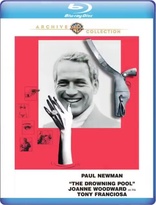The Drowning Pool Blu-ray Movie
HomeThe Drowning Pool Blu-ray Movie 
Warner Bros. | 1975 | 108 min | Rated PG | Feb 27, 2018Movie rating
6.6 | / 10 |
Blu-ray rating
| Users | 4.0 | |
| Reviewer | 3.5 | |
| Overall | 3.5 |
Overview
The Drowning Pool (1975)
Private eye Lew Harper is in deep this time. Hired by an old flame to unravel a seemingly routine blackmail case, he's so far down he may never come up for air.
Starring: Paul Newman, Joanne Woodward, Anthony Franciosa, Murray Hamilton, Gail StricklandDirector: Stuart Rosenberg
| Thriller | Uncertain |
| Mystery | Uncertain |
Specifications
Video
Video codec: MPEG-4 AVC
Video resolution: 1080p
Aspect ratio: 2.40:1
Original aspect ratio: 2.39:1
Audio
English: DTS-HD Master Audio 2.0 Mono (48kHz, 24-bit)
Subtitles
English SDH
Discs
Blu-ray Disc
Single disc (1 BD)
Playback
Region A (B, C untested)
Review
Rating summary
| Movie | 3.5 | |
| Video | 5.0 | |
| Audio | 4.0 | |
| Extras | 2.0 | |
| Overall | 3.5 |
The Drowning Pool Blu-ray Movie Review
The Times They Were A-Changing
Reviewed by Michael Reuben March 17, 2018When Paul Newman returned to the screen as private investigator Lew Harper after a nine-year
hiatus, absence had not made the audience's heart grow fonder. Wily sleuths were already a
familiar sight on TV when Harper was released in
1966, but by 1975 they were legion. More
importantly, the movie culture had changed. Mavericks like Altman, Scorsese, Coppola and
Lucas were redefining notions of film as popular entertainment. And let's not forget the cinemtic
pachyderm that barged into the room just before Harper reappeared like some refugee from a
bygone era. The Drowning Pool was released on July 10, 1975, three weeks after a wunderkind
named Spielberg had already seized the world's attention with Jaws. How could an old-fashioned
detective yarn, even one with a bankable star, hope to compete in the summer that saw the
invention of the modern blockbuster?
But The Drowning Pool has held up over time, and today it's arguably a better viewing
experience than the original Harper. The sequel is sharper and faster-paced, with an efficient
script by Tracy Keenan Wynn (The Longest Yard), Lorenzo
Semple Jr. (3 Days of the Condor)
and Walter Hill (48 Hrs.), and brisk direction by Stuart
Rosenberg, who had previously directed
Newman in three films, including Cool Hand Luke. It
also features vintage New Orleans
locations, stylish cinematography by the late Gordon Willis and the piquant casting of married
couple Newman and Joanne Woodward as remorseful adulterers.

The Drowning Pool's script shifts the action of Ross Macdonald's novel from detective Lew Harper's hometown of Los Angeles to the drawling environs of New Orleans' Big Easy, and the effect is to give the tale an intriguing "fish out of water" subtext. Harper (Newman) makes the trip for a special client, Iris Devereaux (Woodward), who became wealthy by marrying into an old Southern family with vast land holdings surrounding a stately antebellum mansion. The Devereaux clan is ruled with an iron fist by Iris' mother-in-law, Olivia (Coral Browne), whose son (and Iris' husband) James (Richard Derr) is barely in the picture, although he and Iris did manage to produce a rebellious daughter named Schuyler (Melanie Griffith, who had just played a similar teen temptress in Night Moves).
Harper and Iris have history. Six years ago, while Iris was visiting L.A., she and the detective had a passionate one-week romance that both of them still remember with longing and regret. Now, Iris is being blackmailed by someone who has learned of the affair and is threatening to tell her husband. Where else can she turn except to Harper? Who else is better qualified to ensure that this particular secret stays hidden?
Harper may have traded the freeway for the bayou, but he quickly find himself caught in the usual intricate web of passion, greed and deceit on which all good detective stories rely. The Devereaux family is being pressured by a local oil magnate, J.J. Kilbourne (Murray Hamilton, the craven mayor in Jaws), to sell him their land, which is rich with petroleum. Grandma Olivia has steadfastly refused, because she intends to convert the property into an avian refuge. Kilbourne's wife, Mavis (Gail Strickland), is looking to recover a notebook containing . . . well, something incriminating, and she thinks Harper may know where it is. The Devereaux family's recently fired chauffeur, Reavis (Andrew Robinson), is clearly up to no good, in more ways than one. And at least one local cop, Franks (Richard Jaeckel), is no more than a thug for hire, though his boss, Lt. Broussard (Tony Franciosa), seems somewhat more honorable, if not necessarily devoted to truth, justice and the American way.
Harper navigates these unfamiliar waters with his usual sarcastic aplomb, except for the bittersweet moments he shares with Iris, which are freighted with regret for what might have been. Newman and Woodward shared the screen many times during their fifty-year marriage, and here their chemistry provides an undercurrent of unexpected emotion to what might otherwise be a formulaic exercise. Spoiler alert: Just about everyone is bad, there's a murder shortly after Harper arrives, and it isn't the last body to fall before the case is fully unraveled. The "pool" of the title refers to the film's major set piece, in which Harper is imprisoned in an abandoned asylum and interrogated at the business end of a fire hose while encased in a strait jacket. His plan of escape involves flooding the place at the risk of drowning, and this suffocating immersion looks more authentically dangerous than the CG-assisted water in Mission Impossible: Rogue Nation—and yes, that's the star himself getting soaked and struggling for breath.
The Drowning Pool Blu-ray Movie, Video Quality 
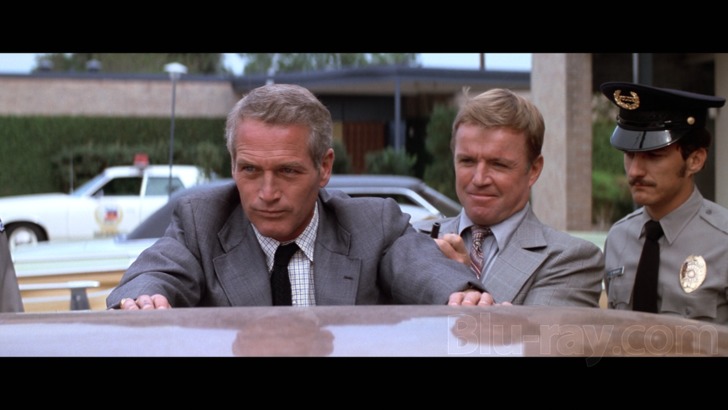
Whatever one may think of Paul Newman's Lew Harper movies, they both had world-class
directors of photography. Harper had Conrad
Hall, and The Drowning Pool had Gordon Willis,
who is justly regarded as an era-defining cinematographer of the Seventies, one who changed the
look of movies with works like The
Godfather, Klute, Annie Hall and All
the President's Men. In
the essential documentary, Visions of
Light, Conrad Hall dubs Willis "the Prince of Darkness"
and speaks with admiration of his colleague's creative use of subdued lighting and
underexposure. Willis's radical experiments nearly got him fired from the first Godfather, when
studio executives viewing the dailies complained that they couldn't see Marlon Brando's eyes.
Similarly, in The Drowning Pool, the DP never misses an opportunity to cast deep shadows over
Paul Newman's famous baby blues. With so much of the film's action set in brightly lit
countryside, you don't expect it to feel like a classical film noir, but with Willis behind the
camera, The Drowning Pool's Louisiana becomes as darkly sinister as Philip Marlowe's L.A.
(See, for example, screenshots 11, 17-22, 25 and 30.) It's a sly visual joke when the film's most
brilliantly lit location is the defunct asylum where Harper is tortured and almost drowned.
For this 1080p, AVC-encoded Blu-ray from the Warner Archive Collection, an interpositive was
scanned at 2K by Warner's Motion Picture Imaging facility. This was the same IP used to
transfer The Drowning Pool for its 2006 DVD, and, as with Harper, the sequel's Blu-ray
presentation receives the benefit of far more advanced technology for both scanning and color
correction. The result is an image of exceptional refinement that brings Gordon Willis' painterly
frames to the home screen with all of their singular style intact. The blacks are deeply black (and
let's not hear any complaints about so-called "crush"; when Willis wanted detail to disappear
into darkness, he didn't hold back). Fine detail is so good that you can even notice Newman's
hair beginning to thin (it fits the character). The Louisiana locations reveal their distinctive
textures, enlivened by flashes of intense color, like the birds kept by Olivia Devereaux, or the
blood-red decor inside Kilbourne's yacht or the parade floats in the scene in a Mardi Gras
warehouse that seems to be de rigueur in every New Orleans-based film. Aliasing, banding or
other distortions are wholly absent.
As per its usual practice, WAC has mastered Harper at a high average bitrate, here 34.99 Mbps.
The Drowning Pool Blu-ray Movie, Audio Quality 
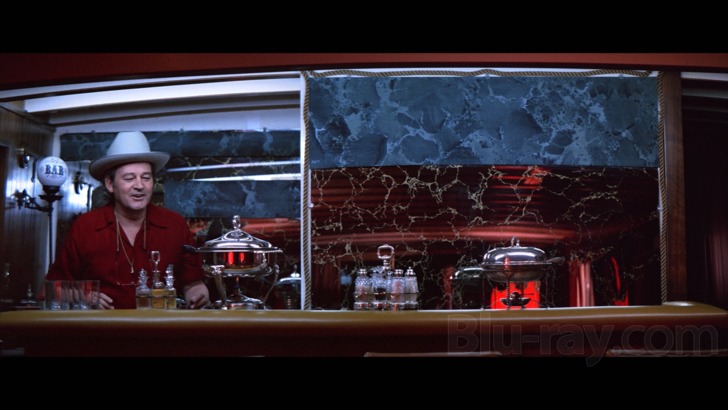
The Drowning Pool's original mono track has been taken from the magnetic master and encoded on Blu-ray in lossless DTS-HD MA 2.0. The mags were found to be in very good condition and required only minimal cleanup. As with Harper, the track is solidly serviceable, effectively prioritizing the dialogue while routinely reminding the viewer that Harper is no longer in his native element, whether with the sounds of the Latin Quarter or the roar of the airboat that ferries the detective to his initial meeting with the slimy Kilbourne. There's some minor gunfire, but the track's most creative sound effects accompany the flooding of the asylum chamber from which Harper has to improvise his escape in the finale, with effective alternation among rushing water, the sloshing surface and muffled reverberations when Harper has to maneuver underwater. Michael Small, who would later score Bob Rafelson's remake of The Postman Always Rings Twice, does his best to create a noirish atmosphere, but his compositions are constantly undermined by the disastrous decision to use an instrumental version of "Killing Me Softly with His Song" as a recurring love theme for Harper and Iris. Roberta Flack's recording had already been a number one hit before Drowning Pool's release, and every time you hear the song's familiar hook on the soundtrack, it's like an invasion from AM radio that takes you right out of the movie. Still, the Blu-ray can't be faulted for faithfully reproducing the filmmakers' bad choices.
The Drowning Pool Blu-ray Movie, Special Features and Extras 
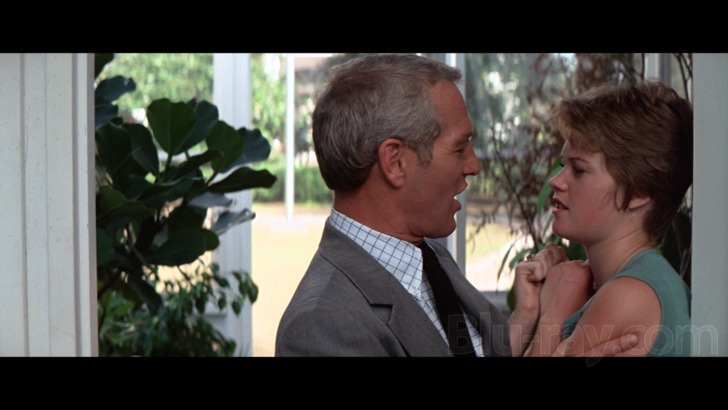
The extras have been ported over from Warner's 2006 DVD of The Drowning Pool, which was
part of the Paul Newman Collection. The trailer has been remastered in 1080p.
- Vintage Featurette: Harper Days Are Here Again (480i; 1.33:1; 10:46): This featurette focuses on the film's New Orleans locations and includes an interview with novelist Ross Macdonald, who comments favorably on the script's change of setting and describes the inspiration for the climactic scene to which the title refers.
- Trailer (1080p; 1.78:1; 231): With breathy voiceover by a female narrator.
The Drowning Pool Blu-ray Movie, Overall Score and Recommendation 
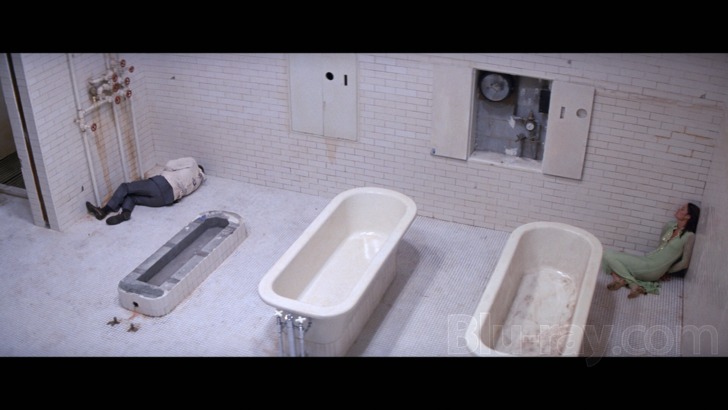
As I said in reviewing Harper, I think The
Drowning Pool has held up better than the film to
which it's a sequel. The direction is sharper, the pacing more energetic, and the screen chemistry
between Newman and Woodward adds spice to the mix. Both movies are lesser entries in Paul
Newman's filmography, but more Newman on Blu-ray is always a good thing, and WAC has
done equally fine work with both films. Highly recommended as a Blu-ray, although, like the
original Harper, the sequel may be an acquired taste.
Similar titles
Similar titles you might also like

Homicide
1991

Farewell, My Lovely
1975

The 39 Steps
1935

Dark Passage
Warner Archive Collection
1947

The Big Sleep
Warner Archive Collection
1946

This Gun for Hire
1942

Mirage
1965

Twilight
1998

Sleuth
1972

Electra Glide in Blue
4K Restoration
1973

The Big Clock
1948

I Confess
Warner Archive Collection
1953

The Woman in the Window
1944

Mulholland Falls
1996

The Mirror Crack'd
1980

Gorky Park
Reissue
1983

21 Bridges
2019

Murder by Decree 4K
1979

Torn Curtain 4K
1966

Murder, My Sweet
Warner Archive Collection
1944
